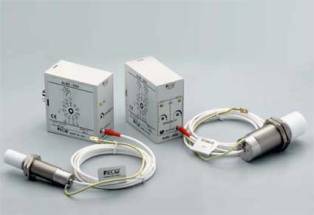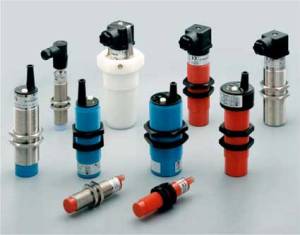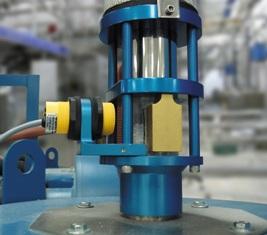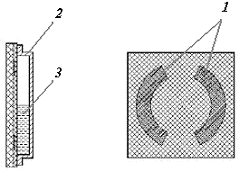Capacitive sensors
A capacitive sensor is called a parametric type transducer where a change in measured value is converted to a change in capacitance.
Capacitive Sensor Applications
The possible applications for capacitive sensors are extremely diverse. They are used in industrial process regulation and control systems in almost all industries. Capacitive sensors are used to control the filling of tanks with liquid, powder or granular substances, such as limit switches on automated lines, conveyors, robots, machining centers, metal cutting machines, in signal systems, for positioning various mechanisms, etc.
Currently, the most widespread are proximity (presence) sensors, which, in addition to their reliability, also have a wide range of advantages. With a relatively low cost, proximity sensors cover a wide range of directionality in their application in all industries. Typical areas of use for capacitive sensors of this type are:
-
signaling for filling plastic or glass containers;
-
control of the filling level of transparent packages;
-
coil breakage alarm;
-
belt tension adjustment;
-
partial account of any kind, etc.
Capacitive linear and angle encoders are the most common devices, widely used in engineering and transport, construction and energy, in various measuring complexes.

Relatively new devices that have come into widespread industrial use in recent years have become small-sized capacitive inclinometers with an electrical output signal proportional to the angle of inclination of the sensor…. The following areas of application of inclinometers can be considered as the main ones: use in platform leveling systems, determination of deviations and deformations of various types of supports and beams, control of inclination angles of roads and railways during their construction, repair and operation, determining the roll of cars, ships and underwater robots, hoists and cranes, excavators, agricultural machinery, determining the angular displacement of various types of rotating objects - shafts, wheels, gearbox mechanisms on both stationary and moving objects .
Capacitive level sensors are used in control systems, regulation and management of production processes in the food, pharmaceutical, chemical, oil refining industries. They are effective when working with liquids, bulk materials, suspensions, viscous substances (conductive and non-conductive), as well as in conditions of condensation, dustiness.
Capacitive sensors are also used in various industries to measure absolute and gauge pressure, thickness of dielectric materials, air humidity, strain, angular and linear accelerations, etc.

Advantages of capacitive sensors over other types of sensors
Capacitive sensors offer a number of advantages over other sensor types. Their advantages include:
-
ease of production, use of cheap materials for production; — small size and weight; — low energy consumption; — high sensitivity;
-
lack of contacts (in some cases — one current collector);
-
long service life;
-
the need for very small forces to move the moving part of the capacitive sensor;
-
ease of adapting the shape of the sensor to different tasks and designs;
Disadvantages of capacitive sensors
Disadvantages of capacitive sensors include:
-
relatively small transfer (conversion) coefficient;
-
high requirements for shielding parts;
-
the need to work at a higher (compared to 50 Hz) frequency;
In most cases, however, sufficient shielding can be achieved due to the sensor design, and practice shows that capacitive sensors give good results at the widely used frequency of 400 Hz. Inherent capacitors the edge effect becomes significant only when the distance between the plates is comparable to the linear dimensions of the surfaces under consideration. This effect can be eliminated to some extent by means of a protective ring, which makes it possible to shift its influence beyond the limits of the surface of the plates actually used for measurements.
Capacitive sensors are remarkable for their simplicity, which allows for a robust and reliable design. The parameters of the capacitor depend only on the geometric characteristics and do not depend on the properties of the materials used, if these materials are correctly selected. Therefore, the effect of temperature on surface changes and plate spacing can be negligibly small by choosing the appropriate grade of metal for the plates and the insulation for their attachment. It remains only to protect the sensor from those environmental factors that can deteriorate the insulation between the plates — from dust, corrosion, humidity, ionizing radiation.
The valuable qualities of capacitive sensors — a small amount of mechanical force required to move its movable part, the ability to adjust the output of the tracking system, and high accuracy of operation — make capacitive sensors indispensable in devices where errors of only hundredths and even thousandths per cent are allowed.
Types of capacitive converters and their design features
Typically, a capacitive sensor is a flat or cylindrical capacitor, one of whose plates undergoes controlled movement, causing a change in capacitance. Neglecting end effects, the capacitance for a flat capacitor can be expressed as follows:

where ε The relative dielectric constant of the medium enclosed between the plates, C and e — the area of the considered plates and, accordingly, the distance between them.
Capacitive transducers can be used to measure various quantities in three directions, depending on the functional relationship of the measured non-electrical quantity with the following parameters:
-
variable dielectric constant of the medium ε;
-
overlapping area of plates C;
-
different distance between the plates e.
In the first case, capacitive transducers can be used to analyze the composition of the substance, since the dielectric constant is a function of the properties of the substance. In this case, the natural input value of the converter will be the composition of the substance filling the space between the plates. Capacitive transducers of this type are especially widely used in measuring the moisture content of solids and liquids, the liquid level, as well as in determining the geometric dimensions of small objects. In most cases of practical use of capacitive transducers, their natural input value is the geometric displacement of the electrodes relative to each other. Based on this principle, linear and angular displacement sensors, devices for measuring forces, vibrations, speed and acceleration, sensors for proximity, pressure and strain sensors (extensometers).

Classification of Capacitive Sensor
In terms of implementation, all capacitive measuring transducers can be divided into single-capacitive and double-capacitive sensors. The latter are differential and semi-differential.
A single capacitance sensor is simple in design and is a single variable capacitor. Its disadvantages include significant influence of external factors such as humidity and temperature.To compensate for these errors, apply differential designs... The disadvantage of such sensors compared to single-capacitance ones is the need for at least three (instead of two) shielded connecting wires between the sensor and the measuring device to suppress the so-called parasitic capacitances. However, this drawback is paid off with a significant increase in accuracy, stability and expansion of the field of application of such devices.
In some cases, a differential capacitive sensor is difficult to create due to design reasons (this is especially true for variable-gap differential sensors). However, if at the same time an exemplary capacitor is placed in the same housing with a working one and they are as identical as possible in design, dimensions and materials used, then a much lower sensitivity of the entire device to external destabilizing influences will be ensured . In such cases, we can talk about a semi-differential capacitive sensor, which, like the differential one, refers to a bi-capacitive one.
The specificity of the output parameter of two-volume sensors, which is represented as a dimensionless ratio of two-dimensional physical quantities (in our case, capacitances), gives reason to call them ratio sensors. When using dual capacitance sensors, the measuring device may not contain any standard capacitance measures at all, which contributes to increasing measurement accuracy.
Linear displacement encoders
The non-electrical quantities to be measured and controlled are many and varied. A significant part of them are linear and angular displacements. Based on a capacitor that electric field two main types of capacitive displacement sensors can be created uniformly in the working gap:
-
with variable electrode area;
-
with a variable gap between the electrodes.
It is quite obvious that the former are more convenient for measuring large displacements (units, tens and hundreds of millimeters), and the latter for measuring small and ultra-small displacements (parts of a millimeter, micrometers and less).
Angular encoders
Angular-displacement capacitive transducers are in principle similar to linear-displacement capacitive transducers, and variable-area sensors are also more suitable in the case of not too small measurement ranges (starting from units of degrees), and variable-angle-gap capacitive sensors can be successfully used to measure small and ultra-small angular displacements. Typically, multi-section transducers with variable capacitor plate area are used for angular displacements.
In such sensors, one of the capacitor electrodes is attached to the shaft of the object, and during rotation it is displaced relative to the stationary one, changing the area of overlap of the capacitor plates. This, in turn, causes a change in capacitance that is captured by the measuring circuit.
Inclinometers
The inclinometer (tilt sensor) is a differential capacitive tilt transducer that includes a capsule-shaped sensing element.

Capacitive inclinometer
The capsule consists of a substrate with two flat electrodes 1, covered with an insulating layer, and a body 2, hermetically fixed to the substrate. The internal cavity of the body is partially filled with a conductive liquid 3, which is the common electrode of a sensitive element.The common electrode forms a differential capacitor with the flat electrodes. The output signal of the sensor is proportional to the value of the capacitance of the differential capacitor, which is linearly dependent on the position of the housing in the vertical plane.
The inclinometer is designed to have a linear dependence of the output signal on the angle of inclination in one so-called working plane and practically does not change the readings in the other (non-working) plane, while its signal is weakly dependent on temperature changes. To determine the position of the plane in space, two inclinometers are used, located at an angle of 90 ° to each other.
Small-sized inclinometers with an electrical output signal proportional to the angle of inclination of the sensor are relatively new devices. Their high accuracy, miniature size, lack of movable mechanical units, ease of installation on the site and low cost make it advisable to use them not only as roll sensors, but also to replace angle sensors with them, not only stationary but also of moving objects.
Capacitive liquid level sensors
A capacitive transmitter for measuring the level of a non-conductive liquid consists of two capacitors connected in parallel
Pressure sensors
One of the basic designs of a capacitive pressure transducer is a single stator, which is used to measure absolute pressure (electrical pressure sensors).
Such a sensor consists of a metal cell divided into two parts by a tightly stretched flat metal diaphragm, on one side of which there is a fixed electrode isolated from the body.The diaphragm electrode forms a variable capacitance, which is included in the measuring circuit. When the pressure is equal on both sides of the diaphragm, the transducer is balanced. A change in pressure in one of the chambers deforms the diaphragm and changes the capacitance, which is fixed by the measuring circuit.
In a two-station (differential) design, the diaphragm moves between two fixed plates and a reference pressure is supplied to one of the two chambers, which provides a direct measurement of the differential (excess or differential) pressure with the smallest error.
